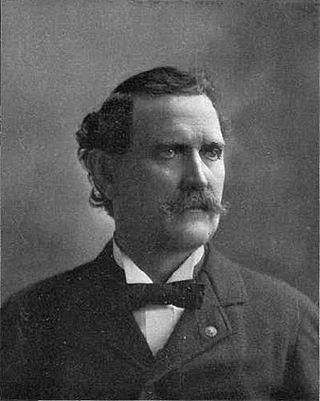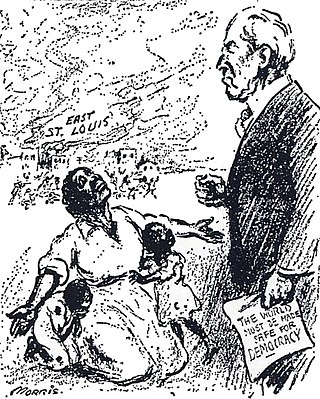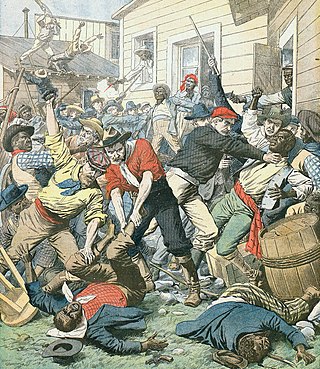Related Research Articles
In the broader context of racism against Black Americans and racism in the United States, mass racial violence in the United States consists of ethnic conflicts and race riots, along with such events as:

Pana is a small town in Christian County, Illinois, United States. A small portion is in Shelby County. The population was 5,199 at the 2020 census.

Virden is a city in Macoupin and Sangamon counties in the U.S. state of Illinois. The population was 3,425 at the 2010 census, and 3,354 at a 2018 estimate.

The United Mine Workers of America is a North American labor union best known for representing coal miners. Today, the Union also represents health care workers, truck drivers, manufacturing workers and public employees in the United States and Canada. Although its main focus has always been on workers and their rights, the UMW of today also advocates for better roads, schools, and universal health care. By 2014, coal mining had largely shifted to open pit mines in Wyoming, and there were only 60,000 active coal miners. The UMW was left with 35,000 members, of whom 20,000 were coal miners, chiefly in underground mines in Kentucky and West Virginia. However it was responsible for pensions and medical benefits for 40,000 retired miners, and for 50,000 spouses and dependents.

John Riley Tanner was the 21st Governor of Illinois, from 1897 until 1901.

The East St. Louis Riots were a series of outbreaks of labor and race-related violence by White Americans who murdered between 39 and 150 African Americans in late May and early July 1917. Another 6,000 black people were left homeless, and the burning and vandalism cost approximately $400,000 in property damage. The events took place in and near East St. Louis, Illinois, an industrial city on the east bank of the Mississippi River, directly opposite the city of St. Louis, Missouri. The July 1917 episode in particular was marked by white-led violence throughout the city. The multi-day riot has been described as the "worst case of labor-related violence in 20th-century American history", and among the worst racial riots in U.S. history.

A strikebreaker is a person who works despite a strike. Strikebreakers are usually individuals who were not employed by the company before the trade union dispute but hired after or during the strike to keep the organization running. Strikebreakers may also refer to workers who cross picket lines to work.

The Herrin massacre took place on June 21–22, 1922 in Herrin, Illinois, in a coal mining area during a nationwide strike by the United Mineworkers of America (UMWA). Although the owner of the mine originally agreed with the union to observe the strike, when the price of coal went up, he hired non-union workers to produce and ship out coal, as he had high debt in start-up costs.
The Westmoreland County coal strike of 1910–1911, or the Westmoreland coal miners' strike, was a strike by coal miners represented by the United Mine Workers of America. The strike is also known as the Slovak Strike because about 70 percent of the miners were Slovak immigrants. It began in Westmoreland County, Pennsylvania, on March 9, 1910, and ended on July 1, 1911. At its height, the strike encompassed 65 mines and 15,000 coal miners. Sixteen people were killed during the strike, nearly all of them striking miners or members of their families. The strike ended in defeat for the union.

Anti-union violence is physical force intended to harm union officials, union organizers, union members, union sympathizers, or their families. It is most commonly used either during union organizing efforts, or during strikes. The aim most often is to prevent a union from forming, to destroy an existing union, or to reduce the effectiveness of a union or a particular strike action. If strikers prevent people or goods to enter or leave a workplace, violence may be used to allow people and goods to pass the picket line.

The Battle of Virden, also known as the Virden Mine Riot and Virden Massacre, was a labor union conflict and a racial conflict in central Illinois that occurred on October 12, 1898. After a United Mine Workers of America local struck a mine in Virden, Illinois, the Chicago-Virden Coal Company hired armed detectives or security guards to accompany African-American strikebreakers to start production again. An armed conflict broke out when the train carrying these men arrived at Virden. Strikers were also armed: a total of five detective/security guards and eight striking mine workers were killed, with five guards and more than thirty miners wounded. In addition, at least one black strikebreaker on the train was wounded. The engineer was shot in the arm. This was one of several fatal conflicts in the area at the turn of the century that reflected both labor union tension and racial violence. Virden, at this point, became a sundown town, and most black miners were expelled from Macoupin County.
The 1920 Alabama coal strike, or the Alabama miners' strike, was a statewide strike of the United Mine Workers of America against coal mine operators. The strike was marked by racial violence, and ended in significant defeat for the union and organized labor in Alabama.
The Pana riot, or Pana massacre, was a coal mining labor conflict and also a racial conflict that occurred on April 10, 1899, in Pana, Illinois, and resulted in the deaths of seven people. It was one of many similar labor conflicts in the coal mining regions of Illinois that occurred in 1898 and 1899.

The Illinois coal wars, also known as the Illinois mine wars and several other names, were a series of labor disputes between 1898 and 1900 in central and southern Illinois.
The 1927 Indiana bituminous strike was a strike by members of the United Mine Workers of America (UMWA) against local bituminous coal companies. Although the struggle raged throughout most of the nation's coal fields, its most serious impact was in western Pennsylvania, including Indiana County. The strike began on April 1, 1927, when almost 200,000 coal miners struck the coal mining companies operating in the Central Competitive Field, after the two sides could not reach an agreement on pay rates. The UMWA was attempting to retain pay raises gained in the contracts it had negotiated in 1922 and 1924, while management, stating that it was under economic pressure from competition with the West Virginia coal mines, was seeking wage reductions. The strike proved to be a disaster for the union, as by 1929, there were only 84,000 paying members of the union, down from 400,000 which belonged to the union in 1920.
The Carbon County Strikes took place in Carbon County, Utah from 1903–1904. The strikes primarily consisted of Slavic and Italian immigrant mine workers who partnered with the United Mine Workers of America strikes in Colorado to protest the dangerous working conditions of the Utah coal mines. The Carbon County strikes were considered the most important labor confrontation in the United States at the time. The Utah Fuel Company strongly opposed initiatives to unionize coal workers in Utah and were the primary opposition to the UMWA at the time. The Carbon County Strikes would ultimately fail in its attempt to unionize the coal workers of Utah simply because it "did not have enough support, either internally or externally, to win against a powerful and influential company that effectively played on radical, anti-foreign sentiments in defending its position" but it demonstrated a significant nationwide effort in strengthening unionization in the west.

Anti-union violence in the United States is physical force intended to harm union officials, union organizers, union members, union sympathizers, or their families. It has most commonly been used either during union organizing efforts, or during strikes. The aim most often is to prevent a union from forming, to destroy an existing union, or to reduce the effectiveness of a union or a particular strike action. If strikers prevent people or goods to enter or leave a workplace, violence may be used to allow people and goods to pass the picket line.
When union violence has occurred, it has frequently been in the context of industrial unrest. Violence has ranged from isolated acts by individuals to wider campaigns of organised violence aimed at furthering union goals within an industrial dispute.

The Spring Valley race riot of 1895 was a violent racial conflict between Eastern and Southern European immigrants and African American coal workers in the mining town of Spring Valley, Illinois. The conflict was in response to the robbery and shooting of Italian miner Barney Rollo, who reported that his assailants were five black men. The assault provoked the town's long-standing social and racial unrest, and many white immigrant workers united against the African American miners. During the investigation into the shooting several black miners were temporarily taken into custody for questioning and many white townspeople began to form a mob, demanding that all blacks be fired and removed from Spring Valley. The mine manager refused, which prompted the white miners to violently riot against both the black miners and their families, forcing them to flee to the nearby town of Princeton.
The lynching of F. W. Stewart occurred shortly after midnight on November 7, 1898, about a mile outside of Lacon, Illinois. Stewart had been accused of the assault of a miner's daughter in Toluca. About one hundred miners formed a mob and broke into the Marshall County jail to retrieve Stewart, who they hanged.
References
- ↑ Markwell, David. “A Turning Point: The Lasting Impact of the 1898 Virden Mine Riot.” Journal of the Illinois State Historical Society , vol. 99, no. 3/4, 2006, p 224
- ↑ Biggers, Jeff “Oct 12, 1898: Battle of Virden” paragraph 13.
- ↑ Foner, Philip S. and Ronald L. Lewis, editors, "The Black Worker: A Documentary History from Colonial Times to the Present, Volume IV: The Black Worker During the Era of the American Federation of Labor and the Railroad Brotherhoods", Temple University Press, Philadelphia, 1979. P.118, or Part III, paragraph 2
- ↑ Gutman, Herbert G, "Work, Culture, and Society in Industrializing America", Vintage Books, New York , 1976 p.184.
- ↑ Lewis, Ronald L, “Black Coal Miners in America”, The University Press of Kentucky, Lexington, 1987, p85.
- ↑ MINERS HANG A NEGRO AT LACON.: LYNCHERS TAKE A PRISONER FROM JAIL IN THE ILLINOIS TOWN AND QUIETLY EXECUTE HIM. IS STRUNG UP TO A TREE. DETERMINED MEN FROM TOLUCA BATTER DOWN THE DOORS OF THE MARSHALL COUNTY JAIL. DIES IN THE EARLY MORNING PUNISHMENT NOT PROBABLE. BLOODHOUNDS ON THE TRAIL. PLANS FOR THE LYNCHING. MOB STORMS THE JAIL. HANGED TO A TREE. Chicago Daily Tribune, (Nov 08, 1898). ProQuest 172865686
- ↑ Angle, Paul M, “Bloody Williamson” University of Illinois Press, Urbana and Chicago, 1952, pp 100-112
- ↑ Carbondale Free Press Sep 23, 1899
- ↑ Aurora Ill Daily Express, Sep 18 1899
- ↑ Lupton, John A, “Virden, Pana, and Carterville Mine Riots” in Rucker, Walter c and James N Upton, “Encyclopedia of American Race Riots”, Greenwood Press, , 2006.
- ↑ Angle, Paul M, “Bloody Williamson” University of Illinois Press, Urbana and Chicago, 952, pp 112-116
- ↑ Roderick, Mary Beth, “Ghost Town: The Rise and Fall of Dewmaine” in The Southern Illinoisian, Nov 20, 2011.
- ↑ Ward, Alonso, “The Specter of Black Labor: African-American Workers in Illinois Before the Great Migration, 1847 To 1910”,
- ↑ Whatley, Warren C. “African-American Strikebreaking from the Civil War to the New Deal.”Social Science History, vol. 17, no. 4, 1993, pp. 525–558.
- ↑ Biggers, Jeff “Oct 12, 1898: Battle of Virden”
- ↑ Markwell, David. “A Turning Point: The Lasting Impact of the 1898 Virden Mine Riot.” Journal of the Illinois State Historical Society , vol. 99, no. 3/4
- ↑ Markwell, David Thomas, ""The Best Organized Labor State in America": The People of District 12 and the Illinois Perspective,1898-1932" (2010).
- ↑ Feurer, Rosemary "Remember Virden! The Coal Mine Wars of 1898-1900",
- ↑ Hicken, Victor, "The Virden and Pana Mine Wars of 1898", Journal of the Illinois State Historical Society, 52, 1959. Reproduced in Macoupin County Il GenWeb:
- ↑ Keiser, John H. “Black Strikebreakers and Racism in Illinois, 1865-1900.” Journal of the Illinois State Historical Society , vol. 65, no. 3, 1972,